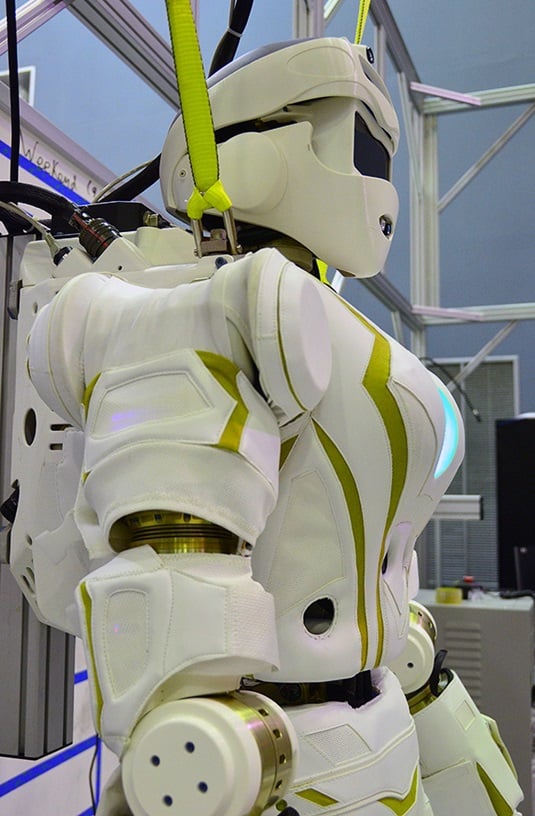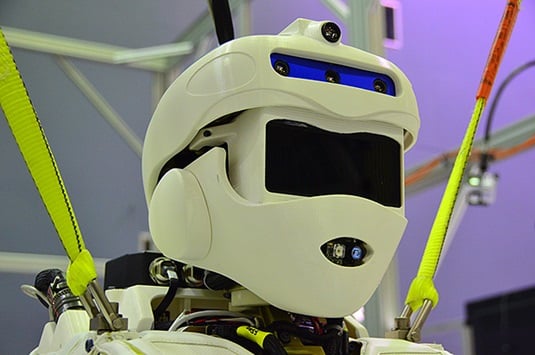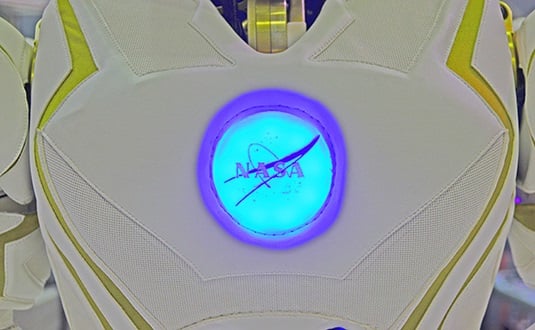This article is more than 1 year old
Meet NASA's Valkyrie: A silky busty robo superhero that'll save your life
Space agency thinks with its Johnson, builds Iron (wo)Man for Mars colony
Video NASA's Johnson Space Center (JSC) has revealed its entry into the $2m DARPA Robotics Challenge, which will start later this month. The result is a robot dubbed Valkyrie that's designed to look like a sexy superhero.

'My eyes are up here, thank you'
The 1.9-metre tall, 125kg droid has interchangeable arms that can be swapped out by removing a single bolt and connector, and three fingers and a thumb on each hand that exceed a human's in strength. It also has an impressive cleavage, thanks to the linear actuators that allow it to swivel, and a glowing NASA icon that looks straight out of Iron Man.
The bipedal robot is built to operate under human control and uses head-mounted stereoscopic cameras and laser range-finding equipment to help its operators find where it's going. A sonar system is also built into the torso, and the robot carries its own hot-swappable two kilowatt-hour battery backpack that's good for 60 minutes of operation.

'Sarah Connor?'
Val, as the robot is known to its builders, will compete for a $2m cash prize from the US military's research and development laboratory in its Robotics Challenge: the goal is to create a robot that can operate in environments built for humans, and conduct search and rescue missions where we fleshy mortals can't safely go.
The competing bots will have to drive a truck to the test site, walk over rubble-strewn floors, open doors, climb ladders and stairs, open and close industrial valves, connect and operate a fire hose – and, if necessary, smash through walls to reach its target and return it to the vehicle.
Val is part of the A team entries, where groups build their own robots to get the job done. B and C teams will use a six-foot two-inch tall ATLAS humanoid robot built by Boston Dynamics. ATLAS' body is protected by a steel cage, but with Team Val wanted a more human feel so clothed the robot in soft fabrics.
See for yourself, here:
Youtube video of the Val robot
"Our robot is soft. If you brush against it while you're working, you don't want to feel this cold, hard metal," JSC team leader Nicolaus Radford told IEEE Spectrum. "You want it to feel natural, like you're working next to another human being. The soft goods, the clothes we put on the robot, give it that feel, that appearance of being more comfortable to be near."
The clothes do have apertures for cameras other than those on Val's head. The robot has cameras built into its forearms (so operators can see what the hands are manipulating) as well as secondary systems built into the thighs and shins for navigation.
But it's not all serious. The glowing chest piece emblazoned with NASA's logo seems to serve little purpose other than making the robot resemble the popular comic (and latterly film) character Iron Man.

Marvel Comics' lawyers may double-take at this
"If it's worth doing, it's worth doing cool," said Radford. "[Valkyrie] has a little bit of a superhero feel to it, because honestly, that's what DARPA's requesting: they want a superhero robot."
DARPA's first trials will take place later this month in Florida to winnow out weaker entries. Judging by some of the problems faced by other teams, there will be a lot of entrants falling by the wayside, but the JSC team feels they've got a winner on their hands.
Even if JSC doesn't win the big prize, the team wants to use Val – or future revisions – as part of a NASA attempt to get humanoid robots on Mars. These droids would be used for exploration, but also to help set up a Martian base for human visitors.
"When the humans arrive, the robots and the humans will work together in conjunction building habs, laying foundations, and working together in a tight relationship," Radford said. "Technologies such as Valkyrie are really going to lead into the types of robotic systems that will one day be the precursor missions before the astronauts go to Mars." ®
